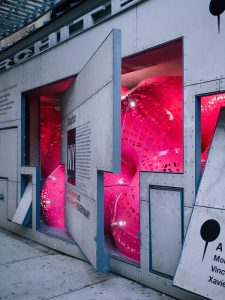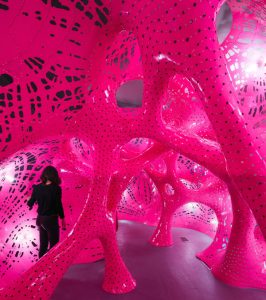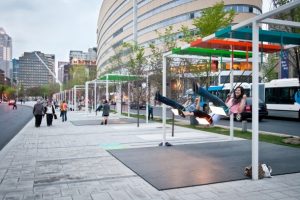var mainRec =0; //main rectangle color
var diam =100; //diameter of main green circle
var blkdiam =100; //diameter of main black circle
var diamSmall =80; //upper left & lower right circle diameters
var diamSmall2 =80; //upper right & lower left circle diameters
var leftCorner1 =10; //x point of white square
var leftCorner2 =10; //y point of white square
function setup() {
createCanvas(640, 480);
}
function draw() {
var newBackground=map(mouseY,0,height,0,255);
background(newBackground);
var firstColor = map(mouseY, 0, height, 151, 255); //sets bounds for first red value
var secondColor = map(mouseY, 0, height, 230,51); //sets bounds for green value
var thirdColor = map(mouseY, 0, height, 0, 210); // sets bounds for blue value
background(firstColor,secondColor,thirdColor);
if ((mouseX > 170) & (mouseX < 470) && //allows for the change of middle rectangle color
(mouseY > 50) && (mouseY < 430)) {
mainRec = mainRec + 1;
}
fill(mainRec);
noStroke();
rect(170,50,300,380); //main long rectangle in center
fill('Aqua');
noStroke();
ellipse(170,50,diamSmall,diamSmall); //upper left corner circle
fill('Aqua');
noStroke();
ellipse(470,430,diamSmall,diamSmall); // lower right corner circle
if (mouseY>height/2) { //this is for upper left & lower right circles
diamSmall -= (diamSmall-1) >= 10; //shrink when mouse < halfway down
} else {
diamSmall += (diamSmall+1) <= 80; //grow when mouse is > halfway down
}
fill('Aqua');
noStroke();
ellipse(470,50,diamSmall2,diamSmall2); //upper right corner circle
fill('Aqua');
noStroke();
ellipse(170,430,diamSmall2,diamSmall2); //lower left corner circle
if (mouseY<height/2) {
diamSmall2 -= (diamSmall2-1) >= 10; //shrink when y is < halfway down
} else {
diamSmall2 += (diamSmall2+1) <= 80; //grow when y is > halfway down
}
push(); //spinning pink ellipse
translate(width/2, height/2);
rotate(millis()/1000);
translate(-width/2, -height/2);
fill('pink');
noStroke();
ellipse(width/2,height/2,450,50);
pop();
push(); //spinning purple ellipse
translate(width/2, height/2);
rotate(-millis()/mouseX); //slightly different rate of speed & opposite directin
translate(-width/2, -height/2);
fill('purple');
noStroke();
ellipse(width/2,height/2,550,50);
pop();
push(); //spinning orange ellipse
translate(width/2, height/2);
rotate(-millis()/1000); //-direction
translate(-width/2,-height/2);
fill('orange');
noStroke();
ellipse(width/2,height/2,450,50);
pop();
push(); //spinning dark pink ellipse
translate(width/2, height/2);
rotate(millis()/mouseX); //slower speed
translate(-width/2,-height/2);
fill('DeepPink');
noStroke();
ellipse(width/2,height/2,550,50);
pop();
fill('Aquamarine'); //middle circle
noStroke();
ellipse(width/2,height/2,diam,diam);
if (mouseX > width/2) { // grows diameter if mouse is < half width
diam += (diam+3) <= 200;
} else {
diam -= (diam-3) >= 100; //shrinks diameter if mouse is > half width
}
fill('black');
noStroke();
ellipse(width/2,height/2,blkdiam,blkdiam);
if (mouseX > width/2) {
blkdiam -= (blkdiam-3) >=30; // shrinks diameter if mouse is < half width
} else {
blkdiam += (blkdiam+3) <=100; //grows diameter if mouse is > half width
}
fill('white'); //rect in upper right corner
noStroke();
rect(leftCorner1,leftCorner2,30,30);
if (mouseX > width/2) { //mouse towards right, rect = lower right
leftCorner1 = 600;
} else {
leftCorner1 =10;
}
if (mouseX > width/2) { //mouse towards left, rect = upper left
leftCorner2 = 440;
} else {
leftCorner2 =10;
}
}
I wanted to make a piece that would overlap with lots of rotating parts. I wanted to use mostly circles and have them grow or shrink depending on mouse position. I tried to keep within a color scheme of oranges, greens, and pinks.
![[OLD – FALL 2016] 15-104 • COMPUTING for CREATIVE PRACTICE](https://courses.ideate.cmu.edu/15-104/f2016/wp-content/uploads/2020/08/stop-banner.png)



